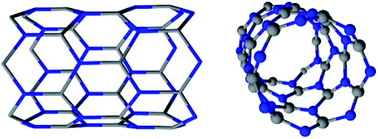Chemical affinity and dispersibility of boron nitride nanotubes†
Abstract
Boron nitride nanotubes (BNNTs) are electrically insulating nanoparticles that display highly competitive elastic modulus and thermal conductivity. Long presented as potential fillers for nanocomposite applications, their poor dispersibility in most commodity polymers has, however, limited their spread. In this work, the chemical affinity of purified BNNTs, measured in terms of Hansen solubility parameters (HSP), were obtained through sedimentation tests in a wide set of organic solvents, taking into account relative sedimentation time. The parameters obtained were {δd; δp; δh} = {16.8; 10.7; 14.7} ± {0.3; 0.9; 0.3} MPa1/2, with a Hildebrand parameter, δt = 24.7 MPa1/2 and a sphere radius of 5.4 MPa1/2. The solubility parameters were determined considering complete dispersion of the purified nanomaterial, as well as the viscosity and density of the host solvent. These factors, combined with the high purity of the BNNTs, are crucial to minimize the uncertainty of the HSP characterization. Such refined values provide necessary insights both to optimize the solvent casting of unmodified BNNTs, and to orient the surface modification efforts that would be needed to integrate these nanomaterials into a wider range of host matrices.



 Please wait while we load your content...
Please wait while we load your content...